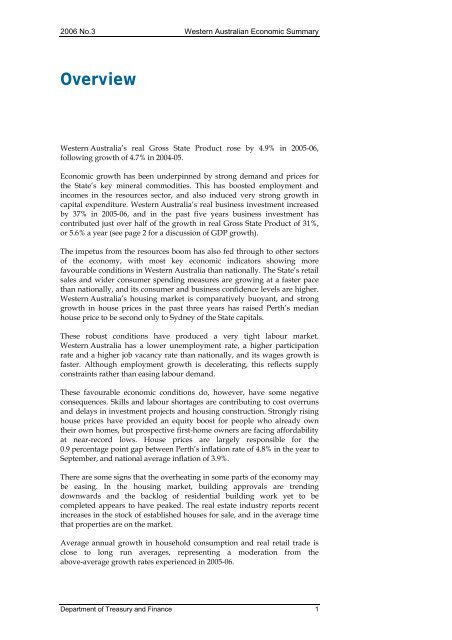No. 3 - Department of Treasury - The Western Australian Government
No. 3 - Department of Treasury - The Western Australian Government
No. 3 - Department of Treasury - The Western Australian Government
Create successful ePaper yourself
Turn your PDF publications into a flip-book with our unique Google optimized e-Paper software.
2006 <strong>No</strong>.3 <strong>Western</strong> <strong>Australian</strong> Economic SummaryOverview<strong>Western</strong> Australia’s real Gross State Product rose by 4.9% in 2005-06,following growth <strong>of</strong> 4.7% in 2004-05.Economic growth has been underpinned by strong demand and prices forthe State’s key mineral commodities. This has boosted employment andincomes in the resources sector, and also induced very strong growth incapital expenditure. <strong>Western</strong> Australia’s real business investment increasedby 37% in 2005-06, and in the past five years business investment hascontributed just over half <strong>of</strong> the growth in real Gross State Product <strong>of</strong> 31%,or 5.6% a year (see page 2 for a discussion <strong>of</strong> GDP growth).<strong>The</strong> impetus from the resources boom has also fed through to other sectors<strong>of</strong> the economy, with most key economic indicators showing morefavourable conditions in <strong>Western</strong> Australia than nationally. <strong>The</strong> State’s retailsales and wider consumer spending measures are growing at a faster pacethan nationally, and its consumer and business confidence levels are higher.<strong>Western</strong> Australia’s housing market is comparatively buoyant, and stronggrowth in house prices in the past three years has raised Perth’s medianhouse price to be second only to Sydney <strong>of</strong> the State capitals.<strong>The</strong>se robust conditions have produced a very tight labour market.<strong>Western</strong> Australia has a lower unemployment rate, a higher participationrate and a higher job vacancy rate than nationally, and its wages growth isfaster. Although employment growth is decelerating, this reflects supplyconstraints rather than easing labour demand.<strong>The</strong>se favourable economic conditions do, however, have some negativeconsequences. Skills and labour shortages are contributing to cost overrunsand delays in investment projects and housing construction. Strongly risinghouse prices have provided an equity boost for people who already owntheir own homes, but prospective first-home owners are facing affordabilityat near-record lows. House prices are largely responsible for the0.9 percentage point gap between Perth’s inflation rate <strong>of</strong> 4.8% in the year toSeptember, and national average inflation <strong>of</strong> 3.9%.<strong>The</strong>re are some signs that the overheating in some parts <strong>of</strong> the economy maybe easing. In the housing market, building approvals are trendingdownwards and the backlog <strong>of</strong> residential building work yet to becompleted appears to have peaked. <strong>The</strong> real estate industry reports recentincreases in the stock <strong>of</strong> established houses for sale, and in the average timethat properties are on the market.Average annual growth in household consumption and real retail trade isclose to long run averages, representing a moderation from theabove-average growth rates experienced in 2005-06.<strong>Department</strong> <strong>of</strong> <strong>Treasury</strong> and Finance 1
















